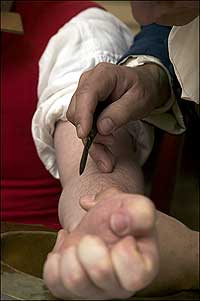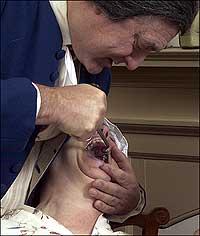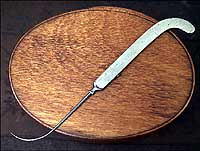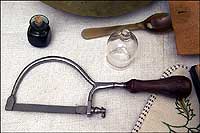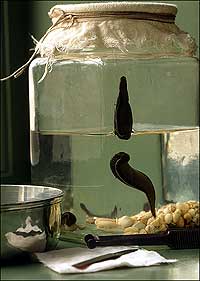That Quacking Sound in Colonial America
by Jim Cox
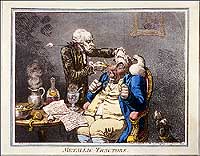
Metallic tractors were one instrument of choice for quack doctors. James Gillray's satiric 1801 print show them at work, sparking the patient's nose into flames and shocking his wig into flight. -National Library of Medicine
One warm afternoon during Colonial Williamsburg's Publick Times a few years ago, when the town was awash with guests and reenactors in eighteenth-century garb and military uniforms, a gentleman and his lady ambled along a road leading to Market Square. On the way they came upon Mistress Moss, the "Herb Lady," who traveled with the 6th North Carolina Regiment. The Herb Lady wore a voluminous, faded-purple shawl dress, a little white bonnet, and tiny framed spectacles over her twinkling green eyes. She sat on the ground by the side of a tent, the tools of her trade spread out on a blanket in front of her—a box containing a wicked looking knife and a carpenter's back saw, pots and gourds filled with colored potions, bags of dried leaves and flowers, bark and sticks.
The gentleman and his lady asked Mistress Moss the significance of the sprigs of lavender they had noticed several of the soldiers wearing in their caps. "To prevent headaches," the Herb Lady said. "But if you already have a headache, you might try some thyme, brewed into a tea. Works wonders."
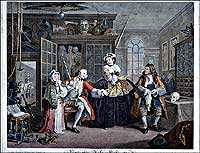
A French doctor of doubtful knowledge tends to a viscount suffering from the pox. The Inspection belongs to Hogarth's first series on weaknesses of the flesh and spirit: Marriage á la Mode. -National Gallery, London.
This led easily to the "doctrine of signatures," one of the scientific theories to which Mistress Moss subscribed. "When you go to a different climate," she said, "you usually find different ailments and diseases. But you also find different plants that the good Lord thoughtfully puts on your doorstep to help you. If you have a heart problem, for example, you look for a plant with heart-shaped leaves or red roots. If you find a plant with swollen joints, you should use it for arthritis. And look at these small seeds from the rose mallow. Are they not in the shape of kidneys? So mallow plants are used for all sorts of kidney complaints."
The Herb Lady was just getting warmed up. Sage is good for a toothache, but if there is a hole in the tooth, the putrid matter must be cleaned out. So shouldn't a tooth aid a tooth? She held up a curved rattlesnake fang. "Isn't this the perfect size and shape for cleaning out a tooth? And if all else fails, I can remove a tooth—as well as a leg or arm."
She pointed to her box of tools. "The doctor has more saws and knives," she said, "but he's just a quack and he'll charge you ten times as much as I will. All you need is a carpenter's saw, a sharp kitchen knife and a blacksmith's tongs to heat red hot for cauterizing. We all have the same success rate in an amputation—about one person saved out of four."
That is not to say that bona fide doctors were feckless or ignorant or mountebanks. To a twenty-first century mind, their treatments and therapies may seem crude or foolish, but the eighteenth-century physician was likely to do, like his counterpart today, the best he could given the knowledge at his command. A thoughtful person will avoid viewing his professionalism by the light of modern medicine, and will distinguish among the varieties and training of the people who aspired to practice the healing arts.
Surgeons were not considered on a social or professional par with physicians in the eighteenth century, Mistress Moss said, because they got their training by apprenticing to a barber or a butcher rather than in a medical school—even though some of the medical schools were little more than diploma mills issuing worthless scraps of paper for a fee. The Herb Lady did not possess any kind of degree, yet she was ready to practice the same kind of medicine as the most educated doctors.
The science of medicine in those days had not grown much from the time of Galen, the court physician to Emperor Marcus Aurelius in second-century Rome who systematized early medical knowledge and whose authority was virtually undisputed until the sixteenth century.
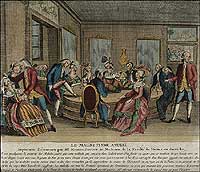
Sweeping across Europe, Mesmerism found favor, temporarily, with Empress Marie Theresa and Marie Antoinette. This 1784 French print shows a séance in progress, with a practitioner at left. -Wellcome Trust
Galen believed that blood, the most important humor, was formed by life-giving spirits in the liver and channeled to the heart. After reaching the other parts of the body, the blood was used up, and the spirits in the liver busied themselves making a fresh supply. Galen's view of physiology persisted for 1,400 years, leading to the belief that the way to restore health was to get the humors back in balance by purging or vomiting, which was achieved by doses of mercury, calomel, or other chemicals and poisons, as well as starving and bloodletting. This came to be known as "heroic" medicine, because the doctor was ready to kill his patients in his attempts to cure them.
The practice of bloodletting came to America with the Europeans and persisted into the eighteenth and early nineteenth centuries. The first United States president, George Washington, died in 1799 of a throat infection after his three physicians bled him. One source says they drained his body of nine pints of blood in twenty-four hours. But of course the blame was laid on his liver, which fell down on the job of replenishment. Bloodletting tools, in use since the fifth century bc, ranged from simple knives and lancets to spring-operated twelve-blade scarificators. And let's not forget the physician's assistants—bloodsucking leeches able to ingest up to ten times their weight in blood.
Bad blood was blamed for just about every ill, so bleeding became a universal treatment. Here, the Herb Lady again: "If your headache has gone on for a while, you're going to require bloodletting from under the tongue. Bleeding is useful in many situations, from a cold to a broken leg. If bloodletting doesn't restore the balance, other treatments must be tried, such as a vomit, a purge, or sweating. For vomit, make a tea from walnut tree bark peeled upwardly. For a purge, peel the bark downwardly."
Here Mistress Moss was applying the gentler arts of folk medicine and the herbalists to the accepted treatments. But the "heroic" doctors were made of sterner stuff. For them, wrote David and Elizabeth Armstrong in The Great American Medicine Show, "Calomel remained in favor, usually combined with medicinal wine, laxative salts, opium, and castor oil. Used to cleanse the system of foul, bilious liquids, this poison caused patients to salivate uncontrollably, bleed from the gums, and evacuate the bowels without restraint. Patients suffered horribly, losing teeth, developing sores on tongue and cheeks, dreading the doctor's call. A popular verse went: 'Doctor comes with free good will, but ne'er forgets his calomel.'"
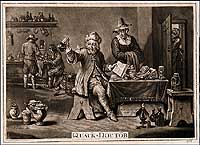
Pills, potions, and panaceas were the stock-in-trade of this fur-capped fraud, who makes a show of medical proficiency with his tabletop of books of esoteric science, flasks and beakers. -Lewis Walpole Library, Yale
Ordinary people often feared and scorned regular doctors for their brutal methods and shaky education, and because their "cures" killed more people than the diseases. Reforms came along, notably the establishment of Johns Hopkins University medical school in 1893. In the meantime, some of the sick of the eighteenth and nineteenth centuries turned to traditional healers—herbalists, Indian medicine men or shamans, and clergymen. Many others treated themselves with family remedies handed down over generations or thumbed through dog-eared self-help books.
In this kind of climate, the doors were wide open for new ideas—but it would be neither fair nor accurate to do as the early physicians did and lump all practitioners of "alternative" medicine under the demeaning term "quack." To use the simplest definition, a quack is someone who claims to have the knowledge and ability to cure disease, but really doesn't and can't. Indeed, by that definition, the established medical profession in England and colonial America was filled with quacks. But there were many enthusiastic "mixologists" who sincerely believed in their nostrums and treatments. Misguided, yes, but not true quacks. The term is reserved for those charlatans who were out to make a quick buck by taking advantage of the gullible, the fearful and the ignorant.
In medieval Europe, "quacksalver" identified a person who sold salves on the street by noisily hawking, or "quacking," his wares. Later, Queen Anne patronized and therefore gave credibility to a number of swindlers and frauds. When someone in the Exchequer realized that licensing the potions that began flooding the market was a cash cow, patent medicines were born.
America's first patent medicine, awarded by the English king in 1715 to Pennsylvanians Thomas and Sybilla Masters, was for Tuscarora Rice, actually a corn "so refined it is also an Excellent medicine in Consumptions & other Diseases." But this was a freewheeling industry, and many if not most of the nostrums were never patented at all, although the term "patent medicine" was applied to all indiscriminately. Indeed, note the Armstrongs, "The manufacturers were far more interested in protecting, through copyright, their trademarks—the unique shapes and colors of the bottles, along with the label designs and printed matter—than their formulas."
English patent medicines—Daffy's Elixir Salutis for "colic and griping," Dr. Bateman's Pectoral Drops, John Hooper's Female Pills, to name but a few—arrived in North America with the first settlers, and dominated the American market until some fifty years after the Revolution. They were sustained in large part by their relationship with the earliest newspapers, which in turn were largely supported by the advertisements of the patent medicine industry, a bed-fellow arrangement that ultimately led to the charge that "printer's ink is the very life-blood of quackery."
American concoctions were not totally shut out. Just before the Revolution Ben Franklin's mother-in-law came out with a salve for lice and itching, calling it Widow Read's Ointment. Old Ben promptly advertised it in the Pennsylvania Gazette. Colonials, however, still showed loyalty to the British brands, which could have proved to be a problem for apothecaries when active hostilities led to a shortage of imported goods. The druggists, with good old-fashioned American resourcefulness, simply rescued old bottles and refilled them with local ingredients. This proved to be so financially satisfying that, when trade opened up again, they ordered empty bottles from British glassworks and filled them in the back room.
What did they fill them with? Much as their British cousins did, with just about anything and everything, including alcohol, opium, and cocaine in various forms, because there were no laws requiring that the manufacturers prove their products were effective—or safe. Going on the theory that more is better, for example, Venice Treacle contained more than 60 ingredients, including flesh of viper. And since the colonials, like the English, subscribed to the notion that the worse the taste, the more effective the medicine, one remedy recommended by Cotton Mather was essentially cow urine and dung. Still, to nobody's surprise, the most popular nostrums were those containing narcotics, which were guaranteed to make the consumer feel better. Most makers, of course, denied that their tonics contained addictive drugs, and insisted that their brews were far safer than the heroic alternatives of the day—bleeding, calomel, prescription drugs, and surgery.
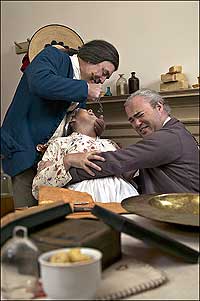
The healing arts were painful and even violent before anesthetics but conducted according to the best knowledge of the day. Carson Hudson pulls Robin Kipps's tooth as Mark Hutter holds her down.
There were still other alternatives available, especially after the colonies became the fledgling United States. One of these was the Thomsonian herbal program, often tagged the first popular quackery movement in America. It was founded by Samuel Thomson of South Carolina, a self-taught healer who scorned educated physicians as "learned quacks." Thomson believed disease was the result of a clogged system and was cured by purging and sweating. He opposed bloodletting and mineral purgatives, touting instead distillates of native American vegetables, and received a patent for his system in 1813. Before internal dissension split and dissolved Thomsonianism in 1838, the movement enlisted one in six Americans.
Shortly before his death, at roughly the same time he was establishing himself as "first in war, first in peace, and first in the hearts of his countrymen," Washington was garnering another, less notable honor—first prominent American to be taken in by the Perkinsian scam.
Elisha Perkins was a Connecticut doctor who, after a brief term at Yale, learned medicine through apprenticeship to his father. A tall, forceful man with great curiosity and a commanding presence, he possessed a shrewdness that enabled him to supplement his medical fees, and support his ten children, by buying, selling, and trading mules. Perkins was also an inventive thinker who tied his creative energies to the tail of Ben Franklin's kite.
This was the opening of the age of electricity. In 1781, Luigi Galvani, an Italian anatomy professor, observed that when he touched a dead frog's muscles with an electric current, the animal's muscles twitched, suggesting that animals respond to electric currents. From this came a wild leap of imagination—that electricity was a life-giving force, an extension of solar energy, a synonym for God. Or at least a restorer of health.
That was the belief of Franz Mesmer, a young Austrian physician, who set out to heal people with electricity and animal magnetism. In Paris, Dr. Mesmer set up a lavish establishment where his patients sat holding hands around a wooden tub of liquid, iron filings, and glass powder from which projected jointed metal rods to touch the ailing parts of their bodies. In the background, from behind curtains covered with astrological symbols, a glass armonica played sweet, heavenly tones that soothed the patients. Then Messmer, in a long purple robe, would enter and touch the afflicted with a white wand, enhancing the magnetic potency of the "universal fluid" and sending them into a trance from which they awakened cured.
In 1784, while representing the United States at the French court, Franklin joined the chemist Lavoisier and the inventor Guillotin in a commission appointed by Louis XVI to investigate Mesmer. The commission reported that they could discover neither electrical nor animal magnetism current in Mesmer's tub. The good doctor left for a comfortable retirement in England.
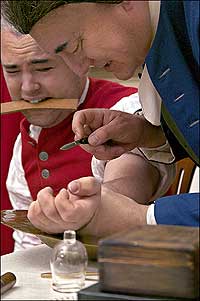
The eighteenth-century version of the universal cure was bloodletting. The genuine physician and the quack alike resorted to it in cases from brain fever to broken legs, colic to cancer.
Elisha's adaptation of the electricity/magnetism phenomenon was nothing so elaborate. He had long held the view, he maintained, that metals possessed an influence on the body that was not fully recognized. This conviction led to his invention of metallic "tractors," a pair of metal instruments each about three inches long, one gold in color, the other silver. Properly stroked across the afflicted surface of the body, the tractors would draw off the noxious electrical fluid that lay at the root of the suffering, bringing blessed relief.
Thousands of citizens bought the tractors, some at $25 a pair, including ministers, physicians, congressmen, the Chief Justice of the Supreme Court, and Washington, who wrote letters recommending the treatment. Perkins won a patent for his tractors in 1795, the first issued by the United States for a medical device. Then the carping started, and when one eminent physician claimed an equal success with a pair of painted wooden sticks, the medical world learned a lot more about placebos—and the world of Elisha Perkins came tumbling down.
In 1796 the Connecticut Medical Society, which Perkins had co-founded, condemned his tractor treatments as "gleaned from the miserable remains of animal magnetism" and expelled him from their ranks. Three years later, when the city of New York was ravaged by an epidemic of yellow fever, Elisha Perkins, hopeful of restoring his good name, took his tractors to town and tried to help. Within a few weeks he caught the fever, died, and was buried with scores of other victims in a potter's field on the present site of Washington Square.
But something good came out of it all. Several members of the Connecticut Medical Society, along with some members of the faculty at Yale, "shocked by the galvanizing trumpery that had arisen in their midst," in their outrage got together and founded Yale Medical School.
Pennsylvania writer Jim Cox contributed to the spring 2003 journal a story on branks, brands, bilboes, and other colonial punishments.

